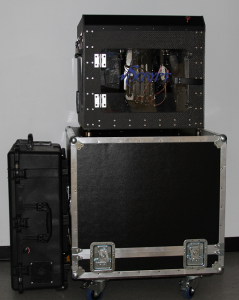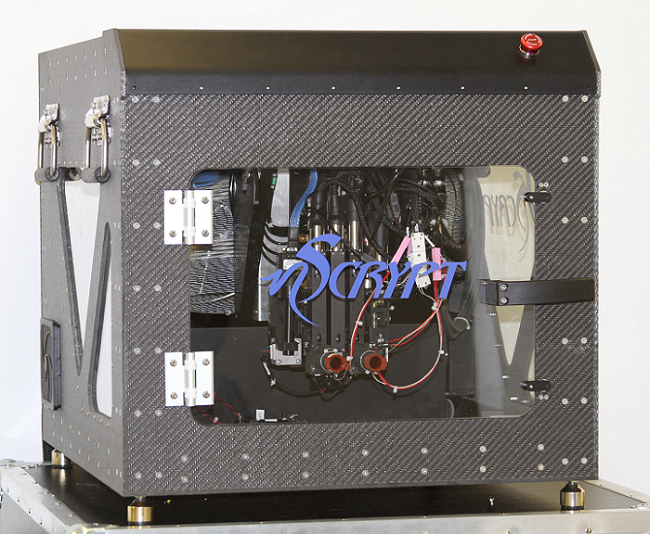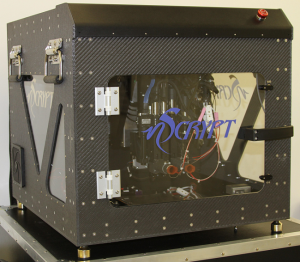nScrypt Sending Rugged Model of 3D Bioprinter to the Desert for Military Experiments in Challenging Climates
 Three years ago, Florida company nScrypt, which was founded in 2002 as a Sciperio spin-out and develops next-generation, high-precision Micro-Dispensing and Direct Digital Manufacturing equipment and solutions for industrial applications, took home the top honor in RAPID’s 2016 Innovation Auditions Competition for its hybrid 3D printer. Since then, nScrypt has continued creating its innovative 3D printing systems, and some important people have taken notice.
Three years ago, Florida company nScrypt, which was founded in 2002 as a Sciperio spin-out and develops next-generation, high-precision Micro-Dispensing and Direct Digital Manufacturing equipment and solutions for industrial applications, took home the top honor in RAPID’s 2016 Innovation Auditions Competition for its hybrid 3D printer. Since then, nScrypt has continued creating its innovative 3D printing systems, and some important people have taken notice.
Over the years, nScrypt and its technology have served a wide variety of industries, such as chemical/pharmaceutical, communications, electronics packaging, life science, printed electronics, solar cell metallization, and 3D printing. But the use cases have been really picking up in the defense and aerospace sectors.
 The company’s technology has been used by the US military for applications such as creating a conformal phased array antenna and munitions, and NASA hopes to use its multi-material 3D printer to develop new sensing technology. In addition, nScrypt’s award-winning BioAssembly Tool (BAT) bioprinter will also be sent up to the International Space Station later this year. Now, the company is sending a rugged version of its BAT, which has been customized for bioprinting in challenging conditions, to the desert as part of a partnership with the US military, the 501(c)3 non-profit Geneva Foundation, and the Uniformed Services University 4D Bio 3 Program.
The company’s technology has been used by the US military for applications such as creating a conformal phased array antenna and munitions, and NASA hopes to use its multi-material 3D printer to develop new sensing technology. In addition, nScrypt’s award-winning BioAssembly Tool (BAT) bioprinter will also be sent up to the International Space Station later this year. Now, the company is sending a rugged version of its BAT, which has been customized for bioprinting in challenging conditions, to the desert as part of a partnership with the US military, the 501(c)3 non-profit Geneva Foundation, and the Uniformed Services University 4D Bio 3 Program.
The team will be shipping the more lightweight version of the BAT, which is also referred to as an austere bioprinter, to a forward-deployed but undisclosed location. There, a team led by LTC Jason Barnhill of the United States Military Academy’s Department of Chemistry and Life Science (West Point) will spend ten weeks experimenting with the bioprinter in the extreme desert environment. As the overall goal of this project is to move 3D bioprinting out of quiet, sterile laboratories and into the real world of challenging, forward-deployed military positions, nScrypt’s BAT will be shrouded in a local environment for protection against the conditions.
Working in the field is generally a rather important necessity when it comes to military service and readiness. We’ve seen 3D printing implemented for many applications in this way, and research continues for other areas in which to use 3D printed items and 3D printing on location – making everything from weapons to water bottles, and figuring out how to recycle waste plastic into filament to make said items. Some teams are even working to achieve successful 3D printing of barracks, or B-Huts, in the field.
By bringing the ability to bioprint point-of-care items like bandages, biologics, biosensors, and stents on-demand to the desert, the warfighter can help improve critical healing and survival in less populated areas, where they would have a difficult time getting easy access to these items. Being able to bioprint on-site in this kind of remote location can give the military a major advantage, as the technology can lower the overall cost of medicine, including the logistics, refrigerated storage, and shipping that would typically be required.
During its time in the desert, the team will put the nScrypt customized 3D bioprinter through its paces, and complete several experimental prints on the system, including mesenchymal stem cells, next-gen wound bandages, and plastic medical models.
What else can we 3D print in the desert? Discuss this and other 3D printing topics at 3DPrintBoard.com or share your thoughts in the Facebook comments below.
[Source/Images: nScrypt]Subscribe to Our Email Newsletter
Stay up-to-date on all the latest news from the 3D printing industry and receive information and offers from third party vendors.
Print Services
Upload your 3D Models and get them printed quickly and efficiently.
You May Also Like
Making 3D Printing Personal: How Faraz Faruqi Is Rethinking Digital Design at MIT CSAIL
What if your 3D printer could think more like an intelligent assistant, able to reason through a design idea, ask questions, and deliver something that works exactly the way the...
Reinventing Reindustrialization: Why NAVWAR Project Manager Spencer Koroly Invented a Made-in-America 3D Printer
It has become virtually impossible to regularly follow additive manufacturing (AM) industry news and not stumble across the term “defense industrial base” (DIB), a concept encompassing all the many diverse...
Heating Up: 3D Systems’ Scott Green Discusses 3D Printing’s Potential in the Data Center Industry
The relentless rise of NVIDIA, the steadily increasing pledges of major private and public investments in national infrastructure projects around the world, and the general cultural obsession with AI have...
Formlabs Teams Up with DMG MORI in Japan
In late June, Nick Graham, Chief Revenue Officer at Formlabs, announced on LinkedIn that the company had partnered with DMG MORI, one of the world’s leading machine tool companies, to...




































